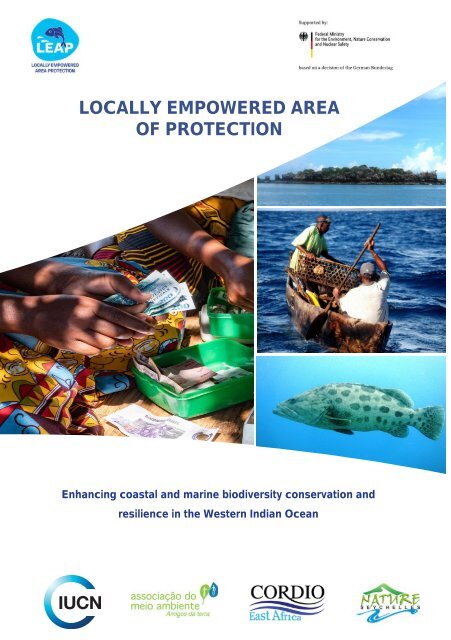LEAP Brochure-web version
You also want an ePaper? Increase the reach of your titles
YUMPU automatically turns print PDFs into web optimized ePapers that Google loves.
LOCALLY EMPOWERED AREA<br />
OF PROTECTION<br />
Enhancing coastal and marine biodiversity conservation and<br />
resilience in the Western Indian Ocean
Background<br />
The coastal and marine environment of the Western Indian Ocean (WIO) region is a hotspot<br />
of biodiversity hosting over 2,200 species of fish, five species of marine turtles and more than<br />
thirty-five marine mammal species. The region boasts of the longest unfragmented fringing<br />
reef in the world, with over 350 species of corals, and a diverse assemblage of coastal forests,<br />
mangrove forests and seagrass beds. It is estimated that about 22% of the species found in<br />
the WIO region are unique to this region. The ecosystem services provided by this rich marine<br />
environment are estimated at over 25 billion US$ per year and more than 60 million people<br />
directly depend on these ecosystems.<br />
Time for action…<br />
Today, because of its particular exposure and vulnerability, the WIO region is facing the full<br />
scale of the climate and biodiversity crisis, directly putting more than 60 million people lives at<br />
risk. 2019 Idai and Kenneth Cyclones are the most recent catastrophic events that illustrate<br />
the urgent need to take action to protect these communities, conserve these ecosystems and<br />
restore their biodiversity so that the people that rely upon them for goods and services as well<br />
as for their livelihoods and income will be less impacted and more resilient<br />
Towards a blue future…<br />
The world is about to enter into a decisive period of its history. The next 10 years (2020-2030)<br />
will determine the future of our and the next generations for centuries. Unprecedented challenges<br />
require unprecedented solutions. Aware of this reality, IUCN has redesigned its WIO<br />
coastal and marine resilience program strategy to efficiently address current challenges. This<br />
new strategy called Towards a Blue Future, is composed of 3 key pillars: Blue Planet, Blue<br />
People and Blue Partnerships.<br />
The Blue Planet pillar aims at securing the integrity of critical marine and<br />
coastal ecosystems. The Blue People pillar aims at increasing ocean leadership<br />
and benefits to the people.<br />
The Blue People pillar aims at increasing ocean leadership and benefits to<br />
the people.<br />
The Blue Partnerships pillar aims at establishing the necessary partnerships<br />
to dramatically accelerate marine and coastal conservation at scale.<br />
This strategy aims at responding to the needs of the WIO region, both in terms of conservation<br />
and development. Because keeping ecosystems healthy and protecting biodiversity provides<br />
so many benefits, unlocking the potential of WIO’s natural capital by promoting the development<br />
of a blue economy represents a unique opportunity.
The project<br />
The International Union for Conservation of<br />
Nature (IUCN) in partnership Nature Seychelles,<br />
Associação do Meio Ambiente (AMA) and<br />
Coastal Oceans Research and Development –<br />
Indian Ocean (CORDIO) are implementing an<br />
initiative titled Locally Empowered Area Protection<br />
(<strong>LEAP</strong>) with funding from the International Climate<br />
Initiative (IKI) of the German Federal Ministry for<br />
the Environment, Nature Conservation and Nuclear<br />
Safety (BMU). This initiative is a direct contribution<br />
to IUCN’s Towards a blue future strategy.<br />
The overall objective of the <strong>LEAP</strong> project is that by 2023, the effective management of coastal,<br />
island and marine biodiversity and ecosystem services in Mozambique, Seychelles, Kenya and<br />
Tanzania is improved through adoption of locally-relevant conservation area governance<br />
frameworks by national governments and non-state actors.<br />
The initiative is investing in policy-related activities as well as infrastructure, conservation and<br />
restoration actions, training and equipment, public awareness programmes, and introduction of<br />
sustainable funding mechanisms.<br />
Improve<br />
governance<br />
Improve<br />
management<br />
Output<br />
1<br />
Output<br />
2<br />
Output<br />
3<br />
Output<br />
4<br />
Improve<br />
policies<br />
Improve awareness<br />
and knowledge
Output 1: Improved locally-relevant governance frameworks are developed and promoted<br />
to support equity and effectiveness in the design, decision-making and benefit sharing in<br />
at least 7 coastal, island and marine conservation areas in Mozambique and Seychelles.<br />
Output 2: Protected and conserved area planning, assessment and sustainable<br />
management tools developed and/or operationalized in at least 7 key sites in Mozambique<br />
and Seychelles<br />
Output 3: Knowledge and awareness products on locally-appropriate PA governance<br />
and management approaches are developed and disseminated among local c<br />
ommunities, civil society, private sector and government in Mozambique, Seychelles,<br />
Kenya and Tanzania.<br />
Output 4: National policy and regulatory frameworks are strengthened through an<br />
evidence based policy advocacy/review in Mozambique, Seychelles, Kenya and Tanzania<br />
Supported by the Federal Ministry for the Environment, Nature Conservation and<br />
Nuclear Safety (BMU)


















